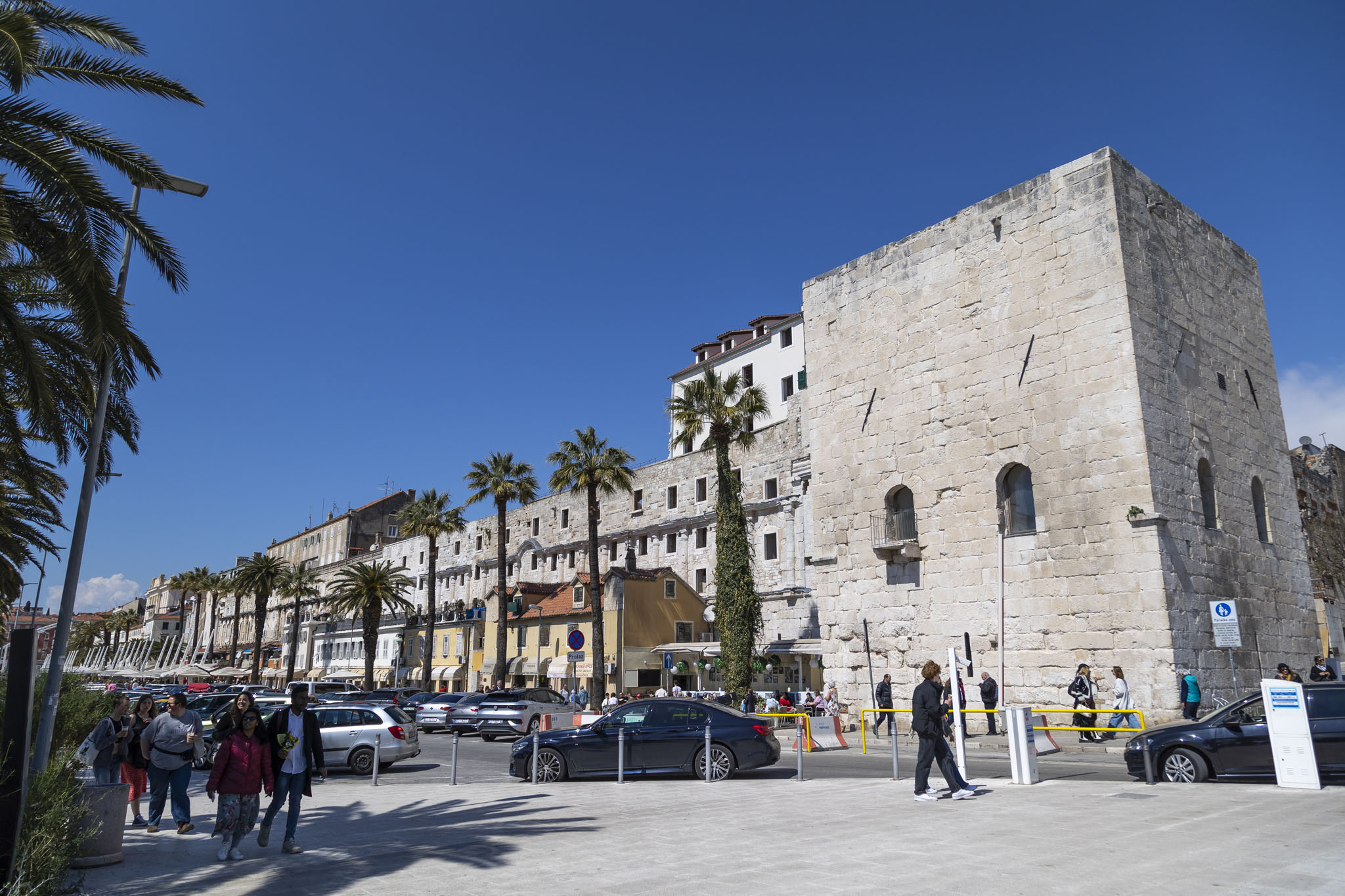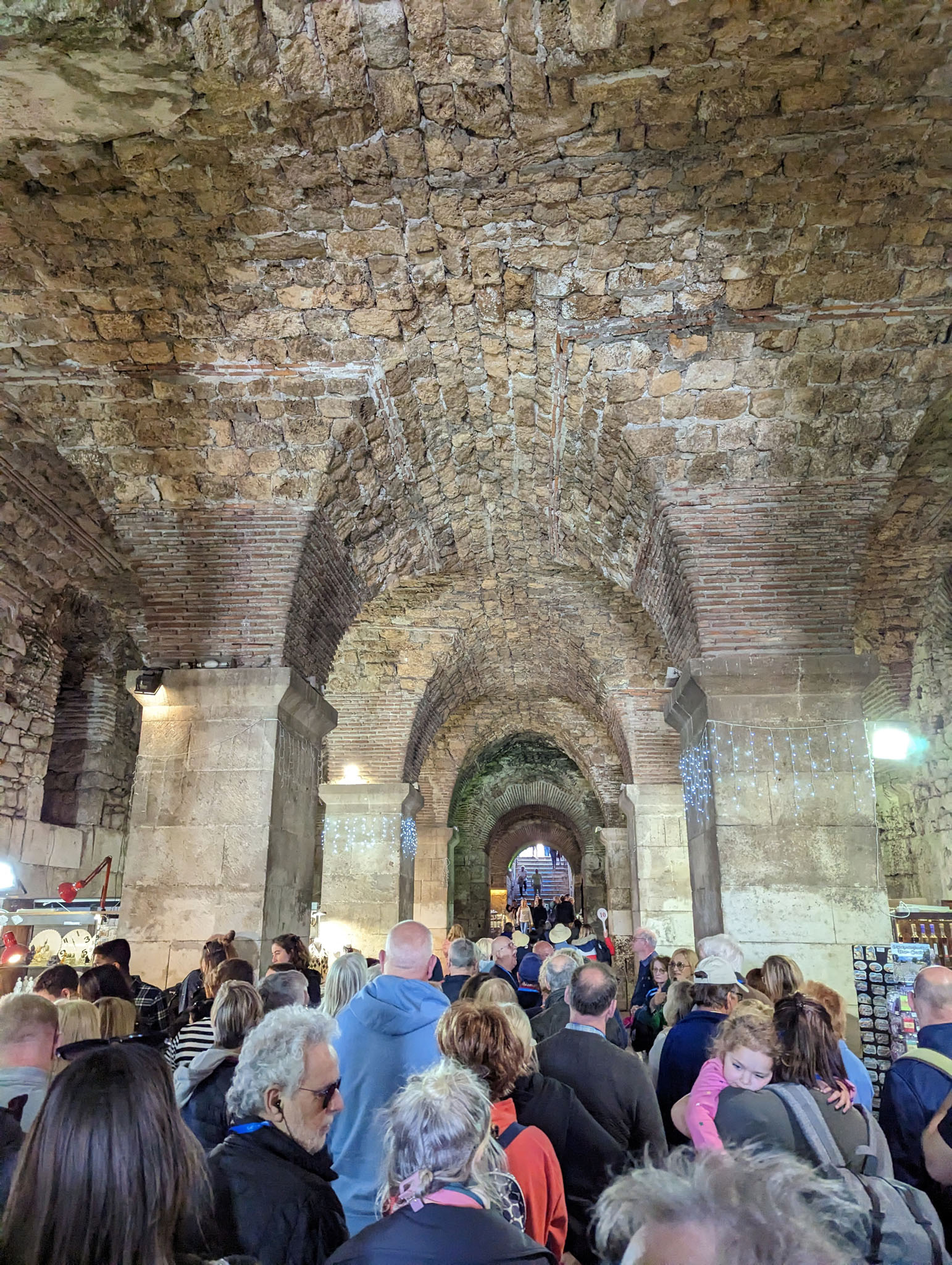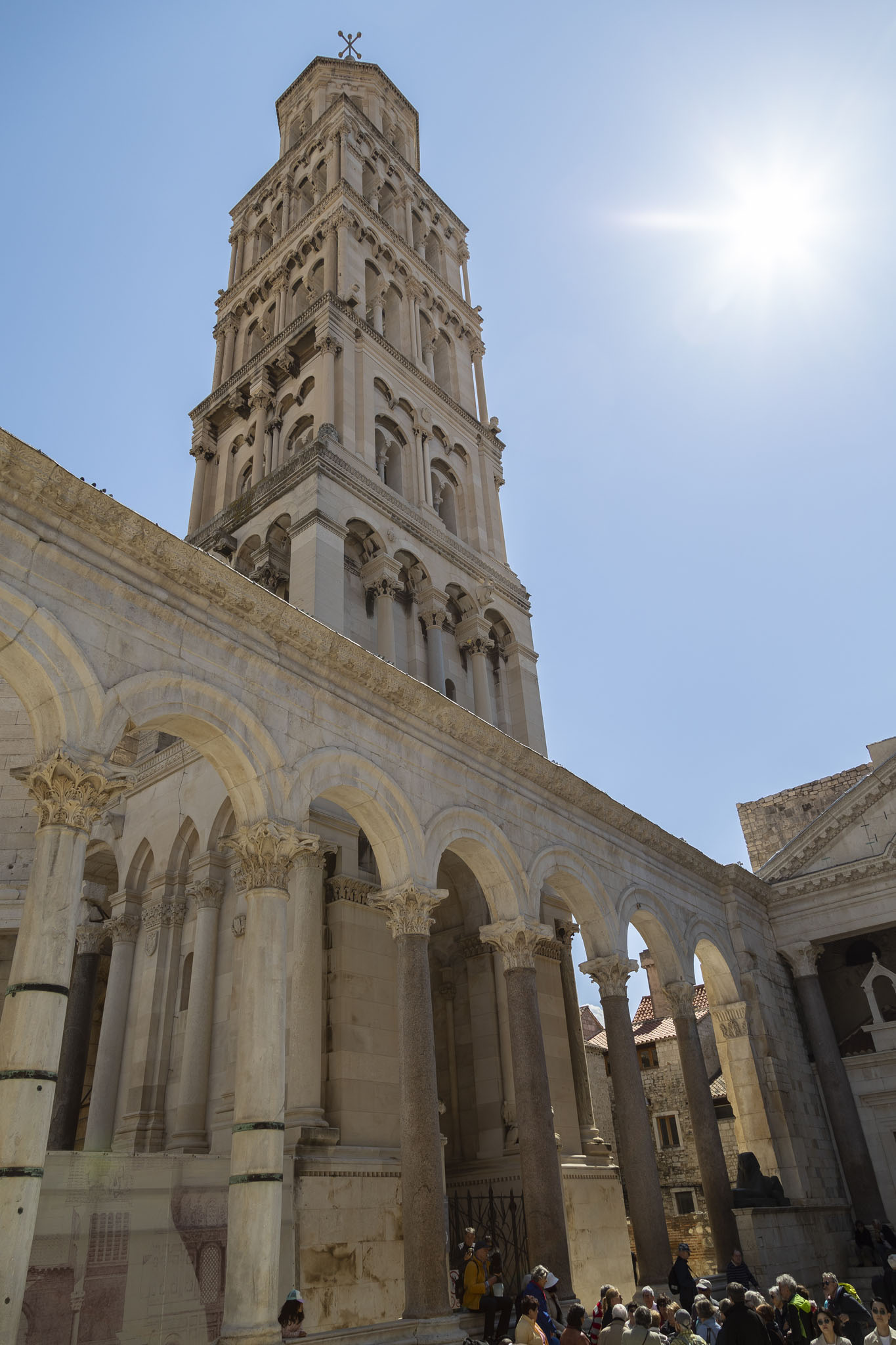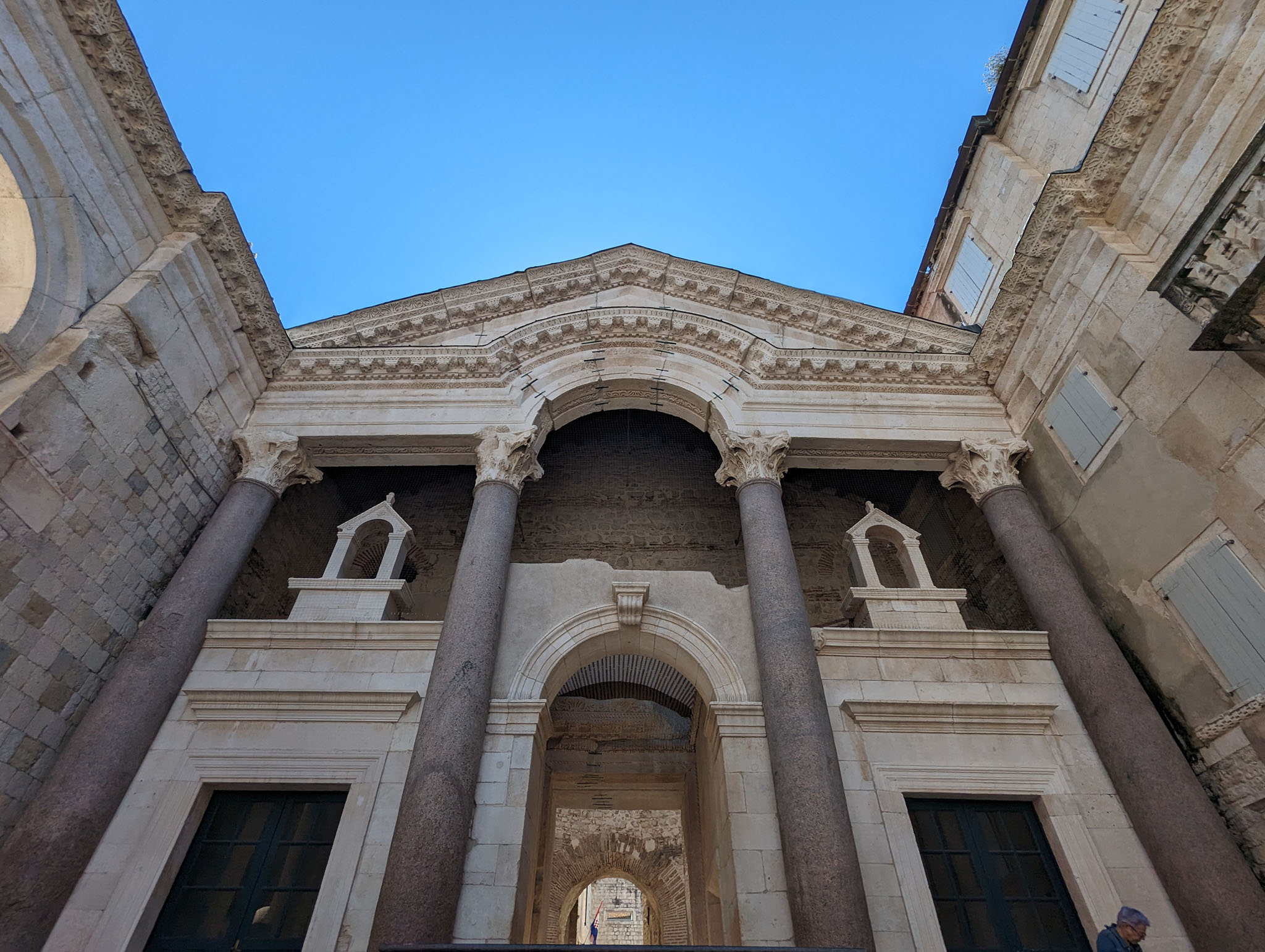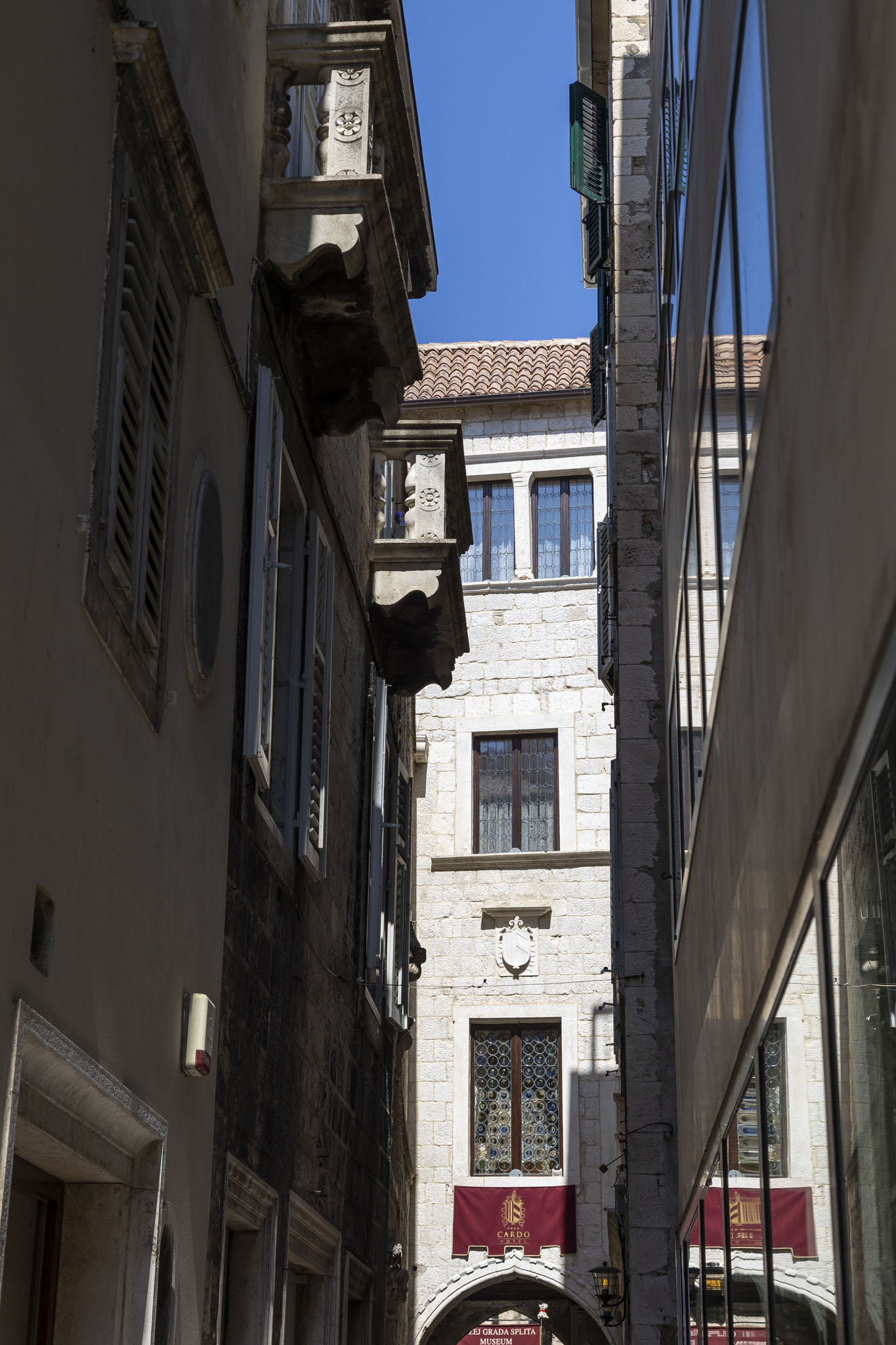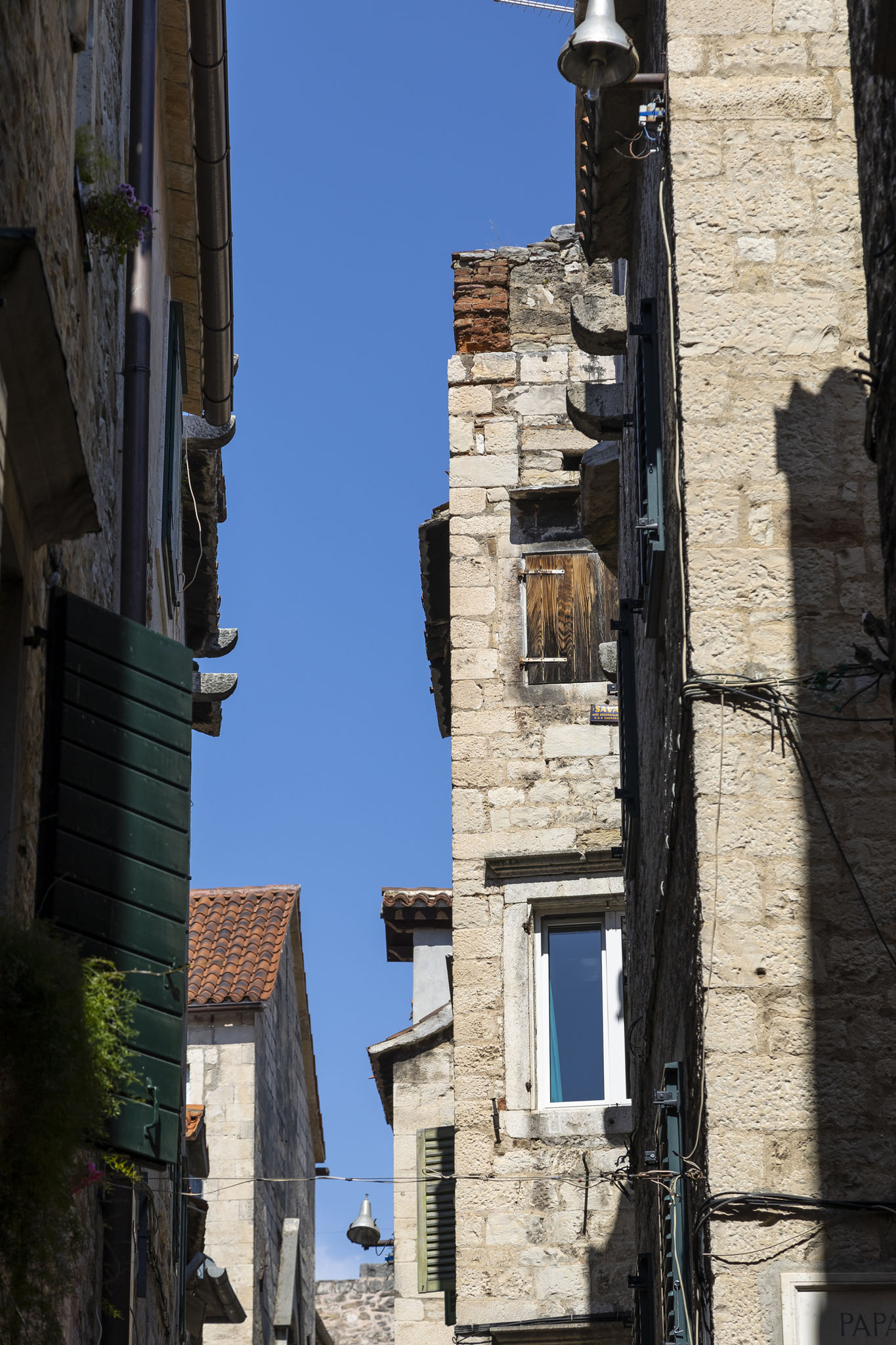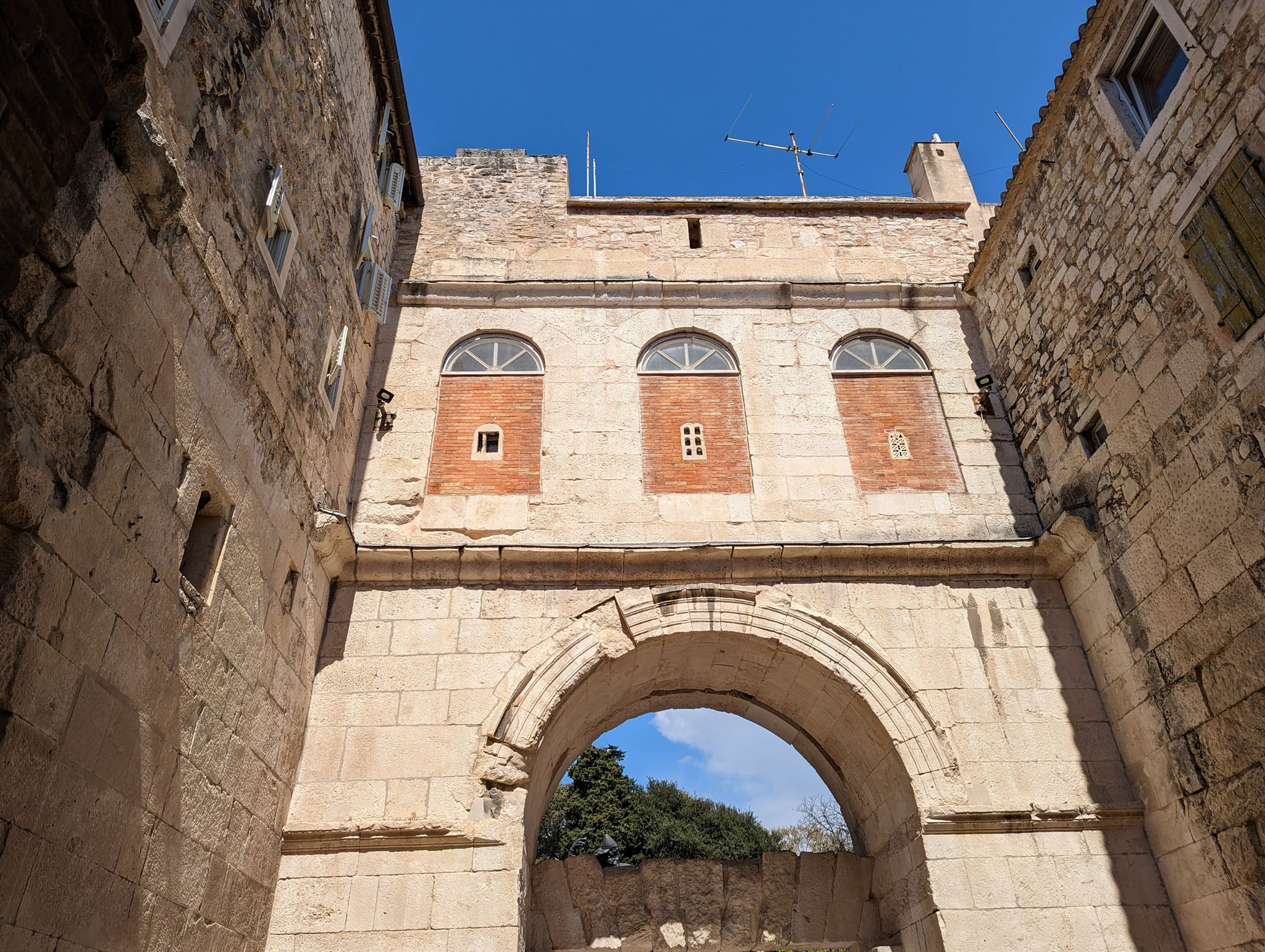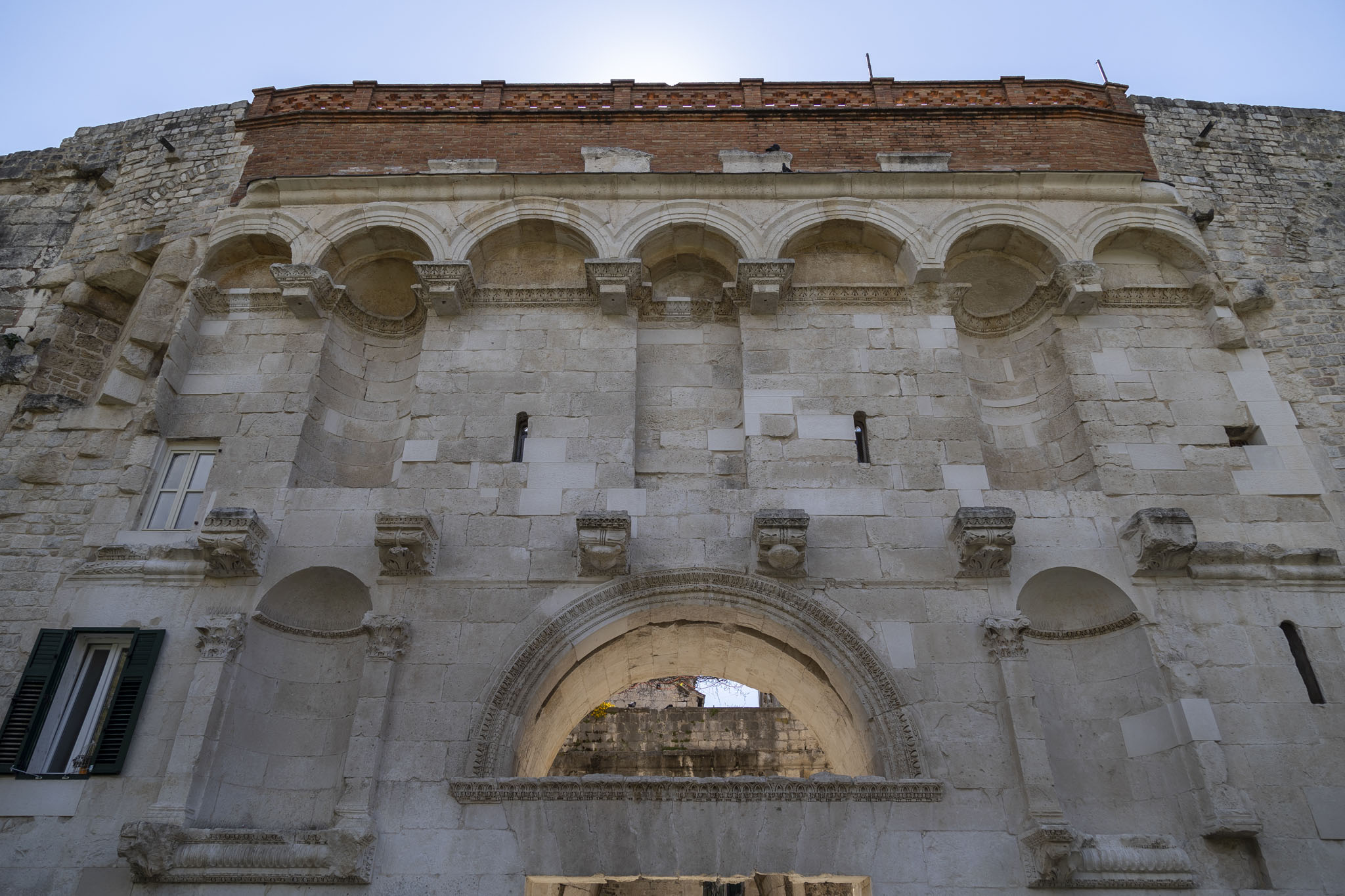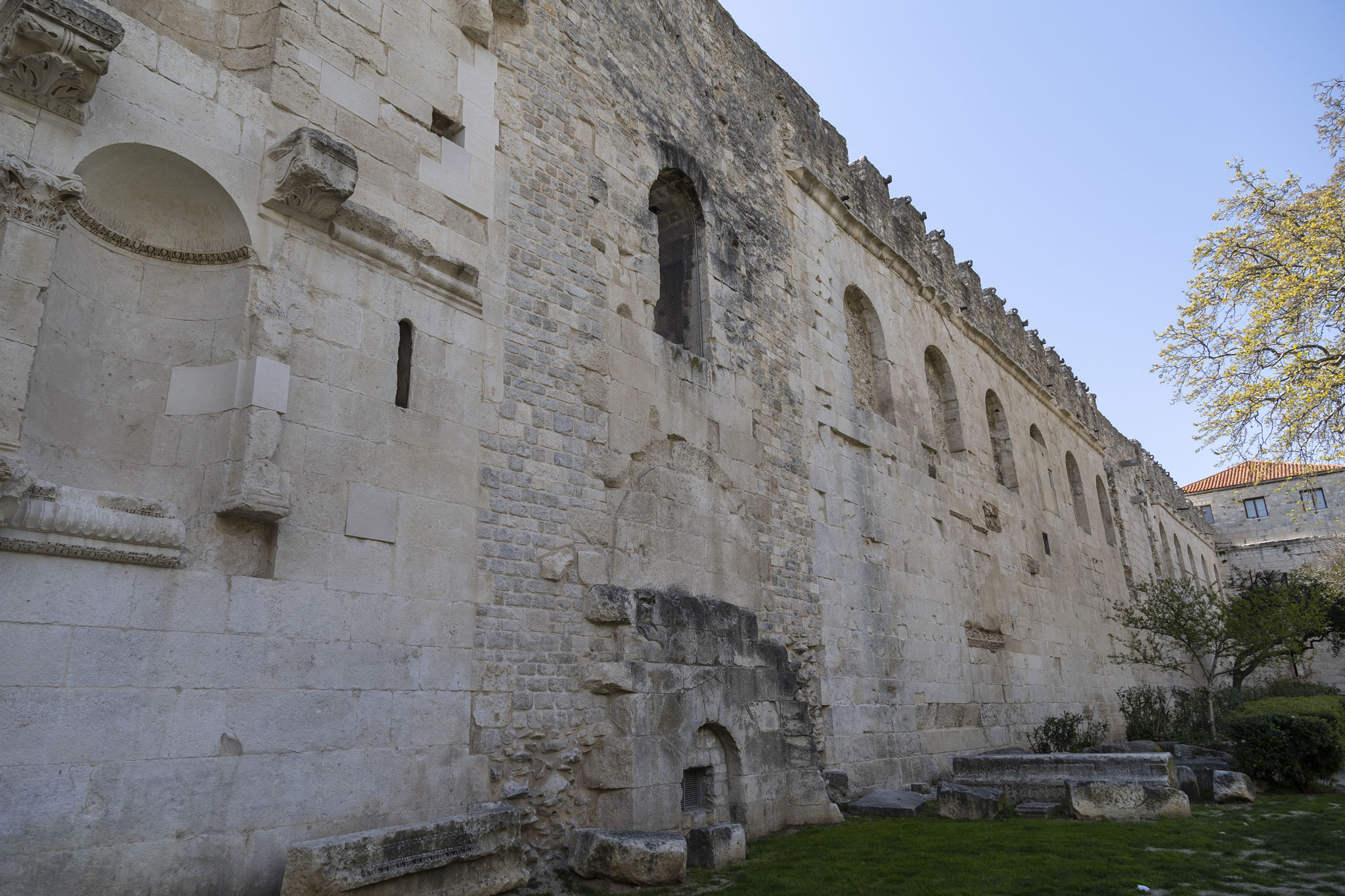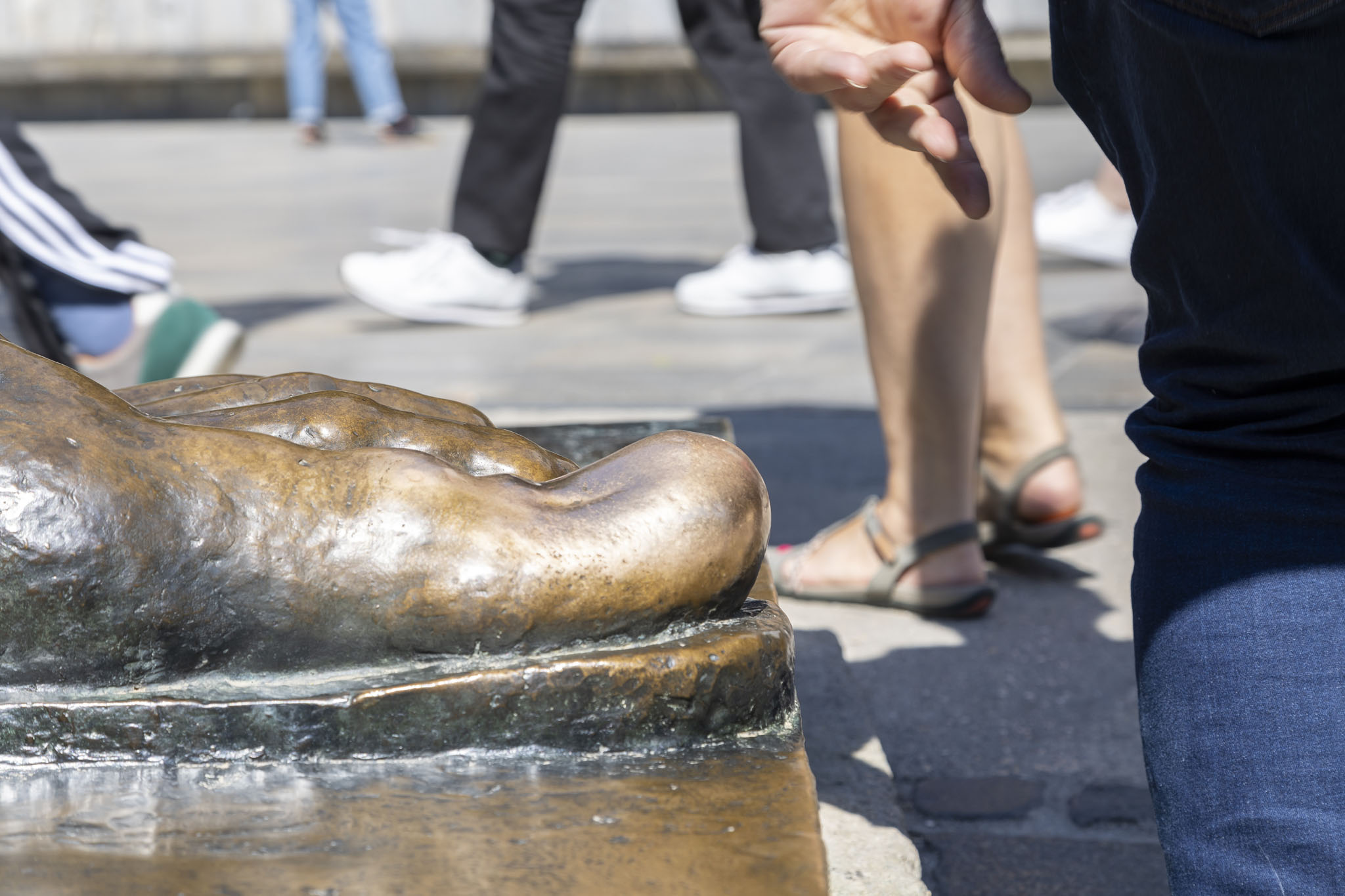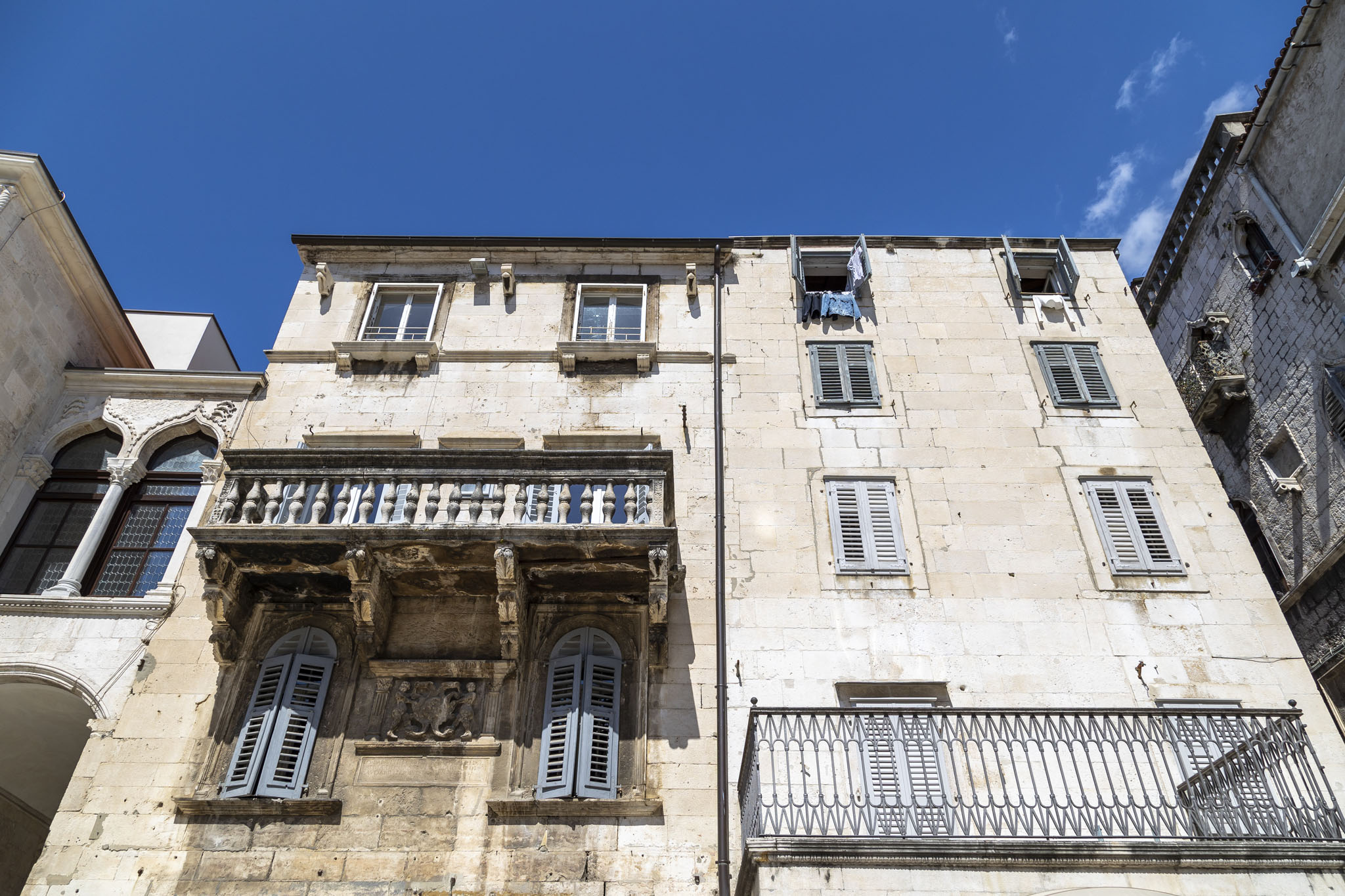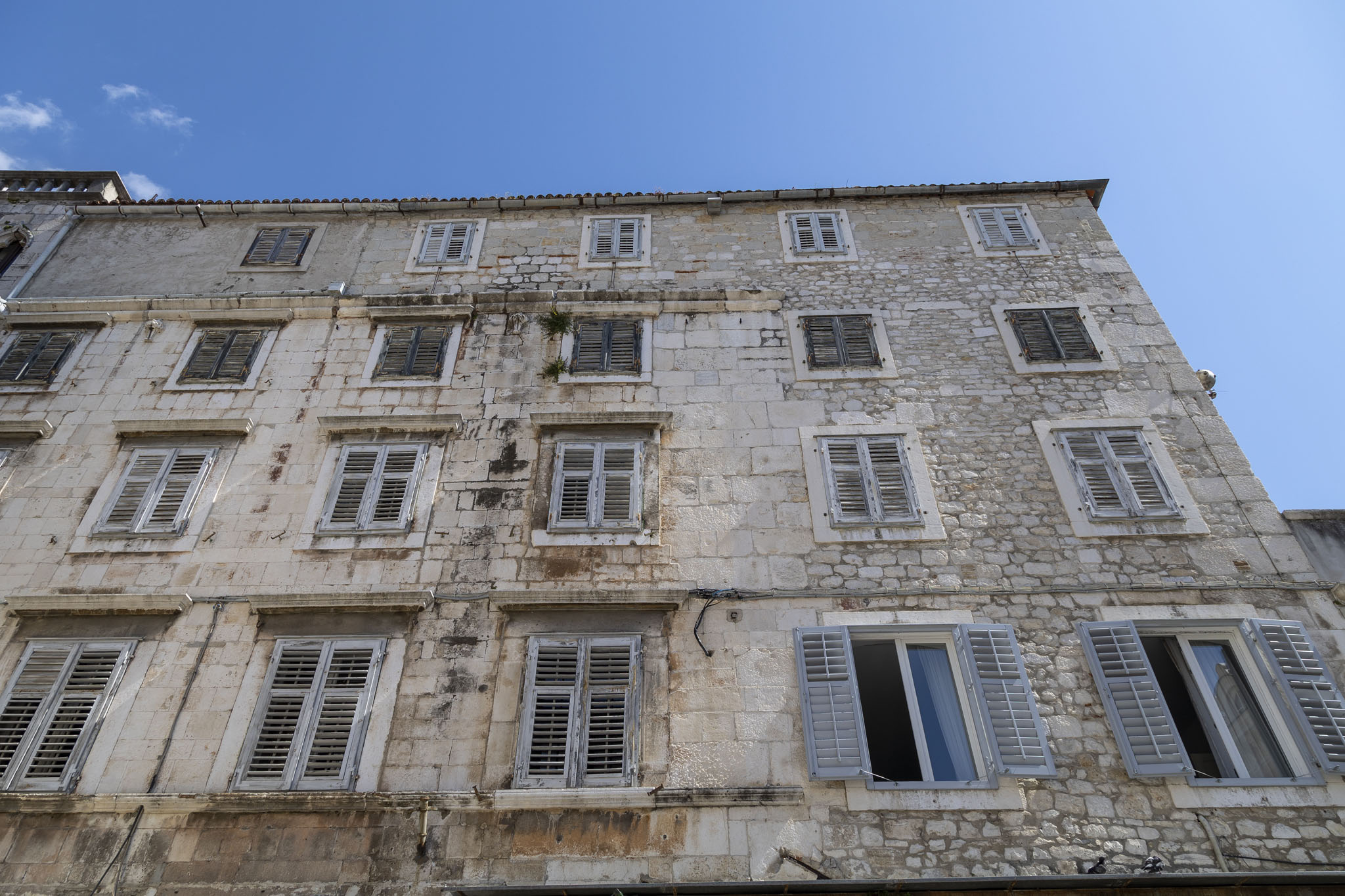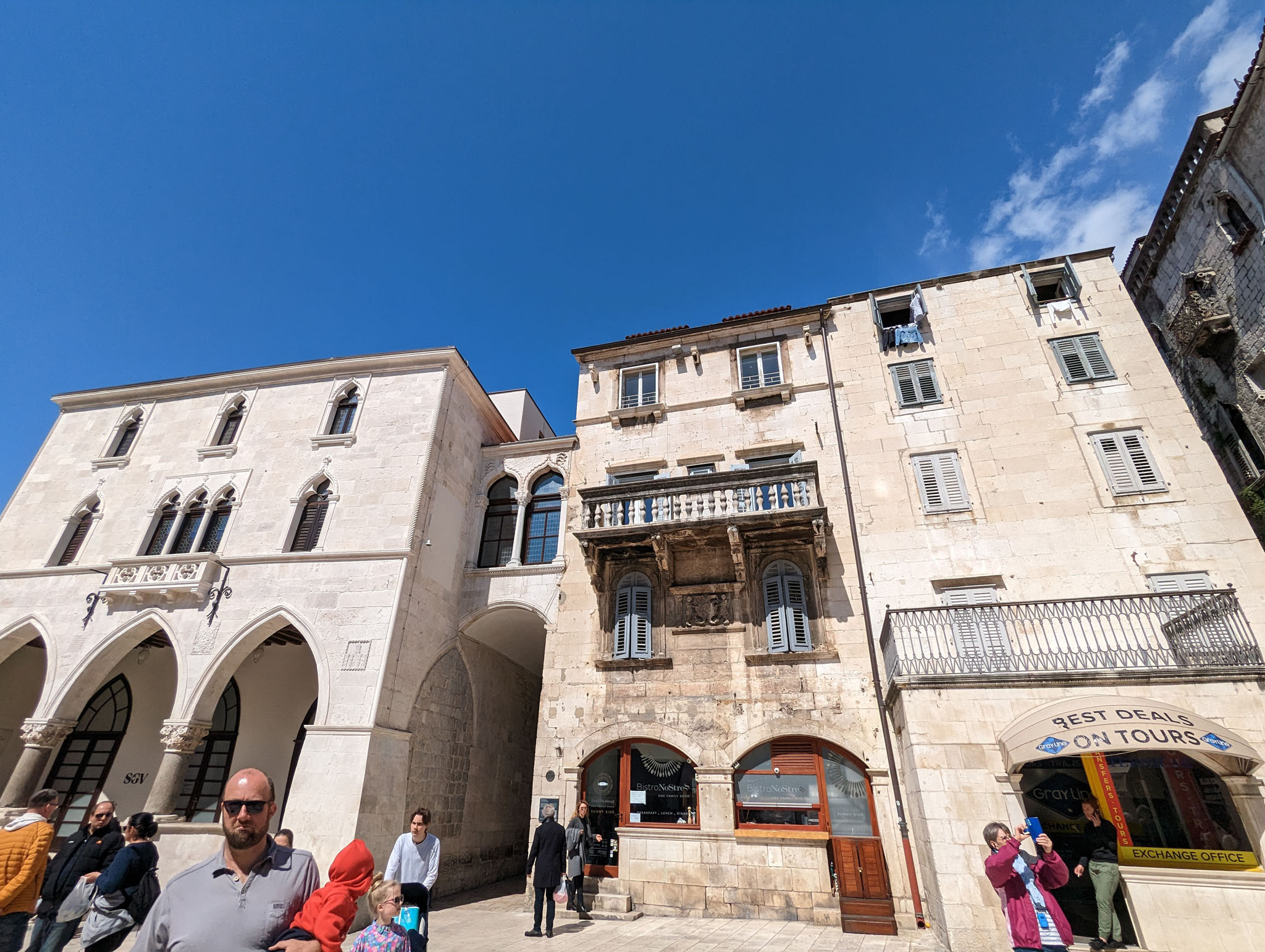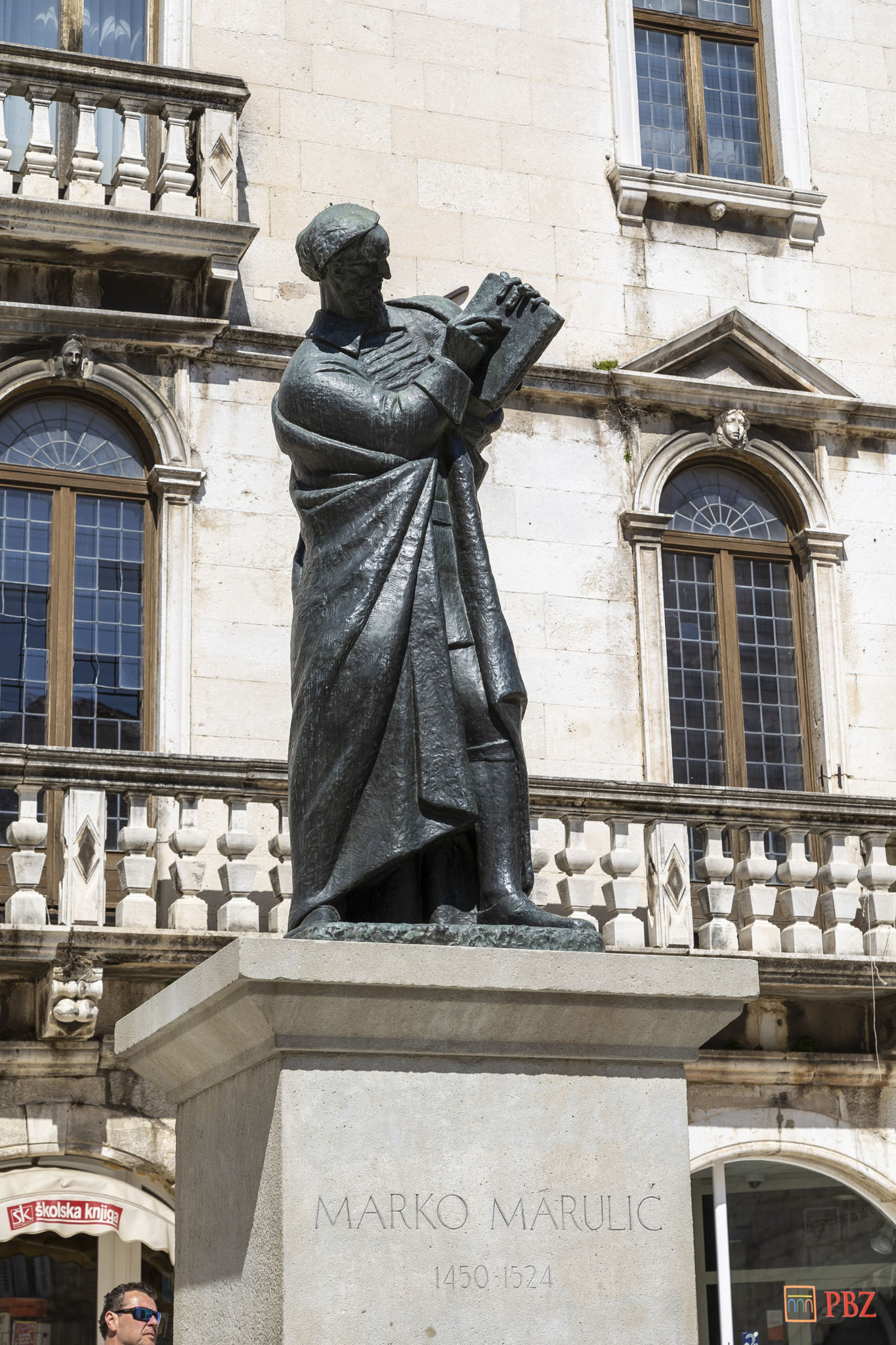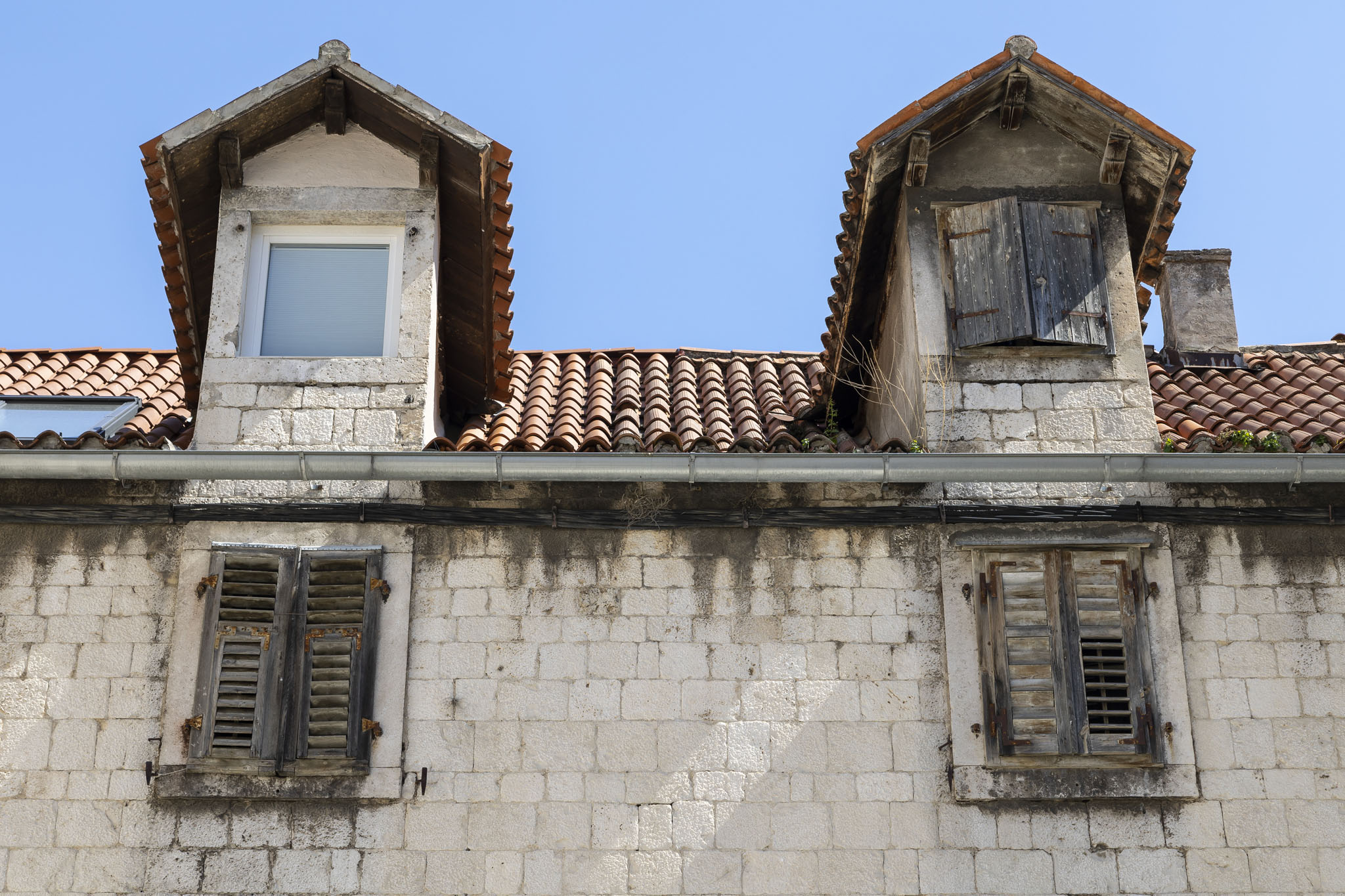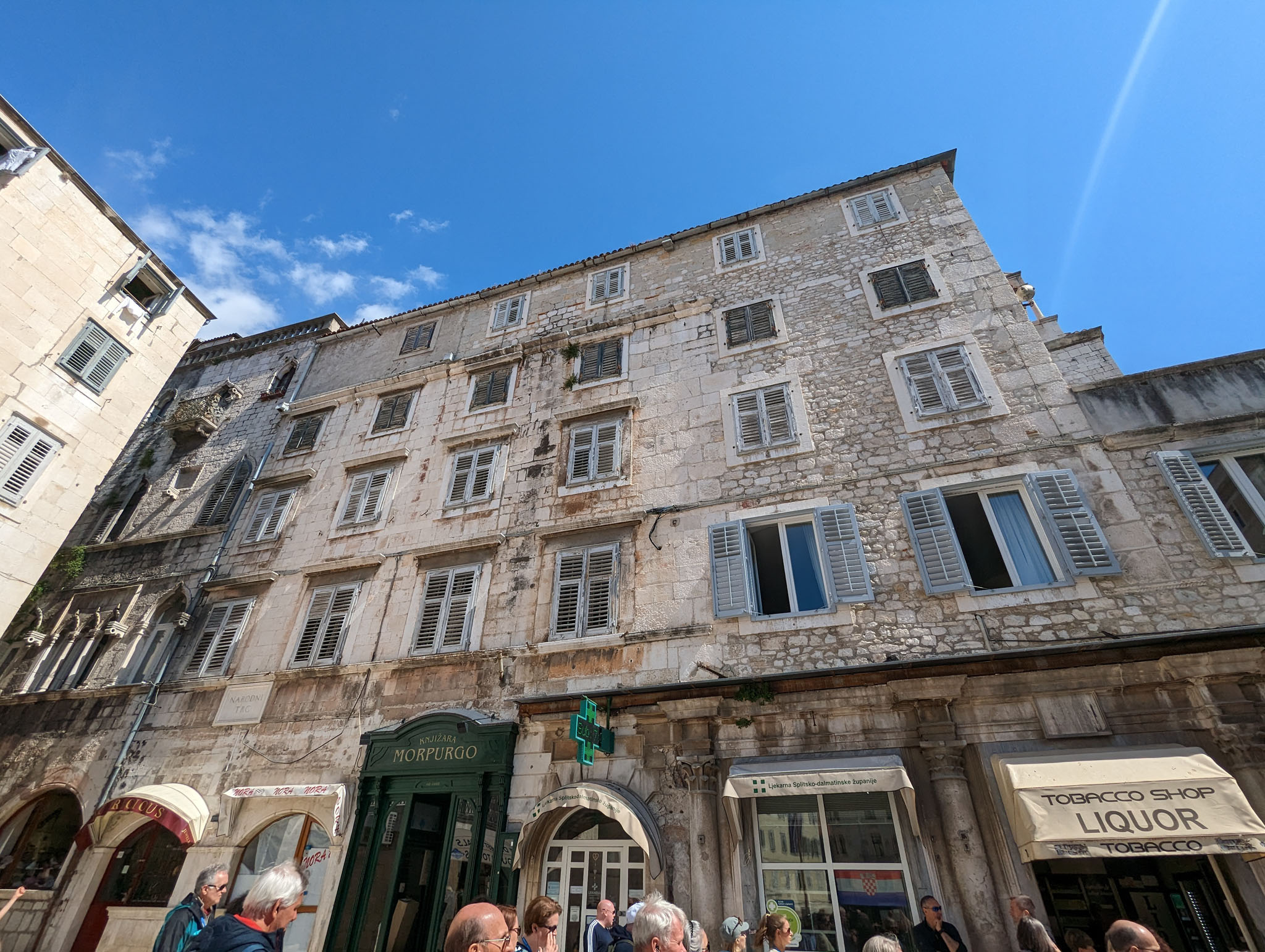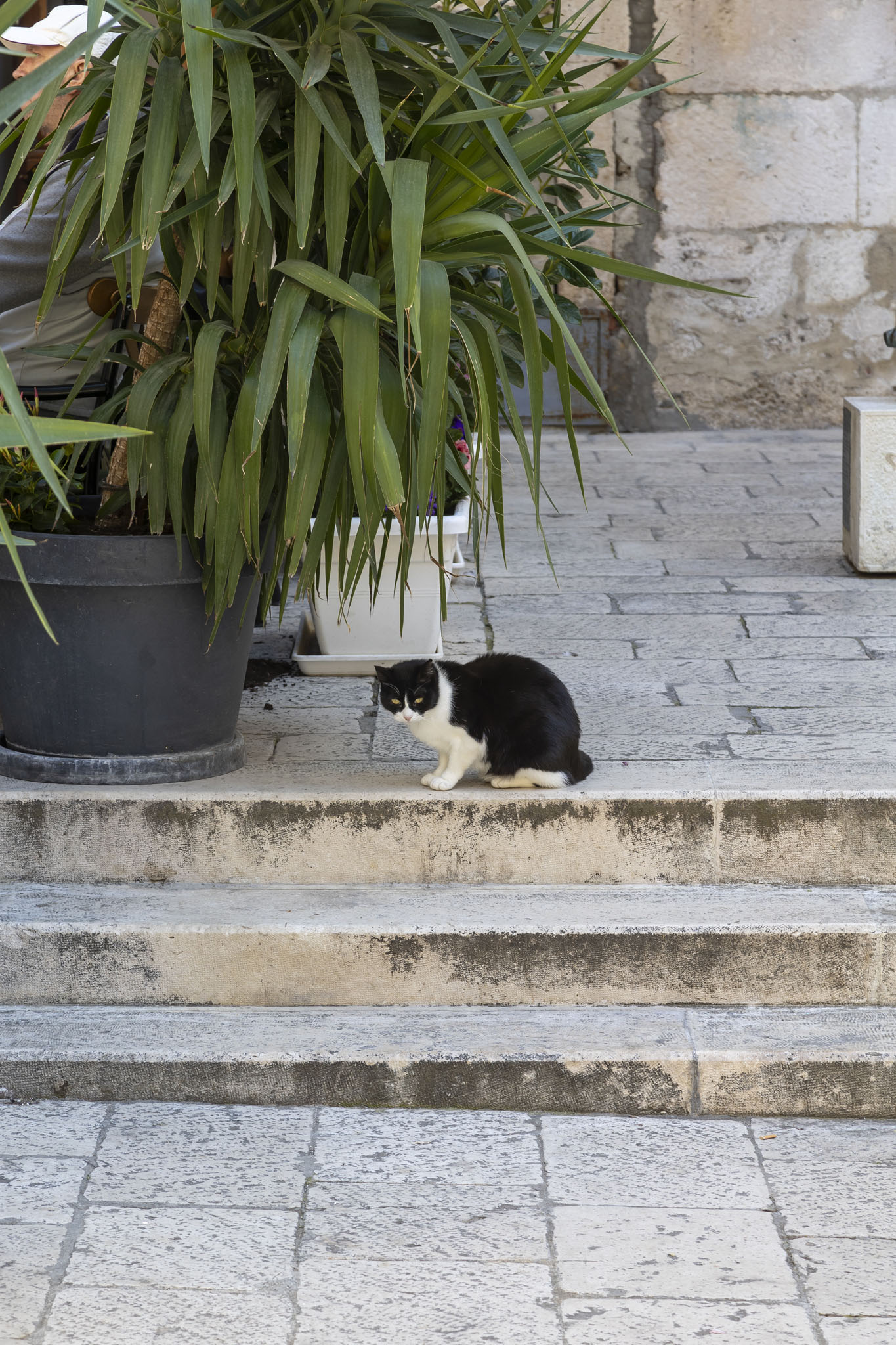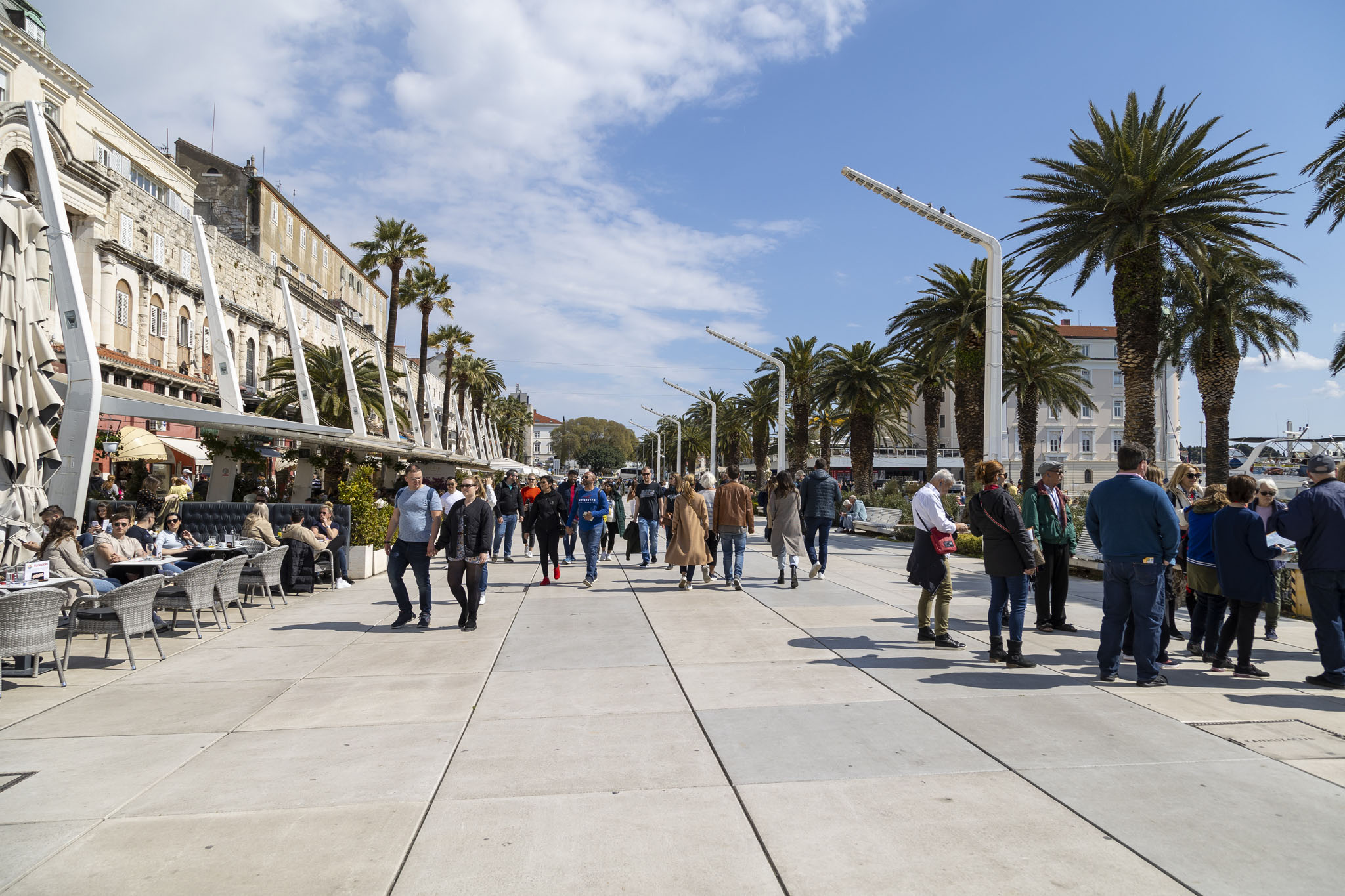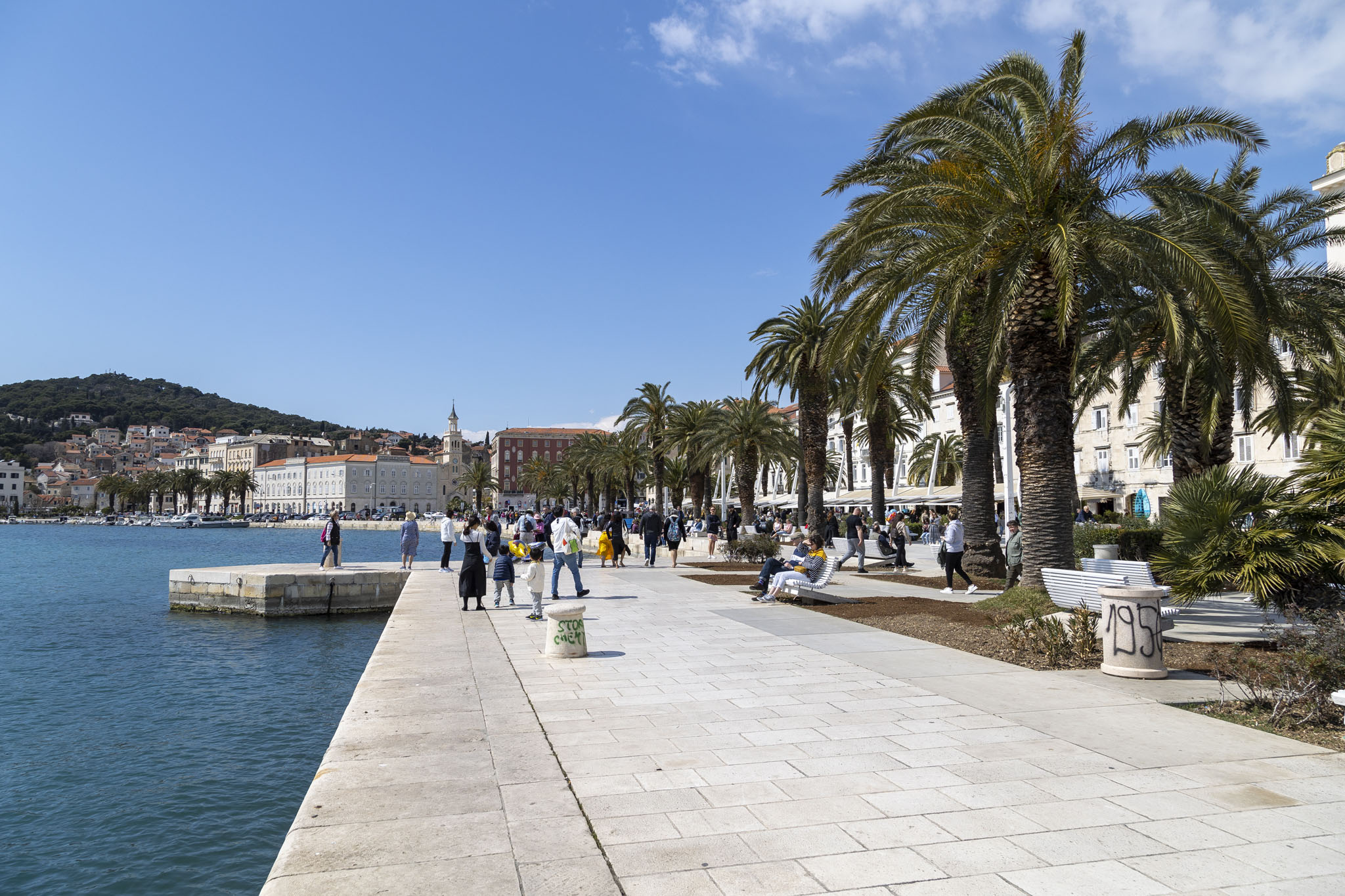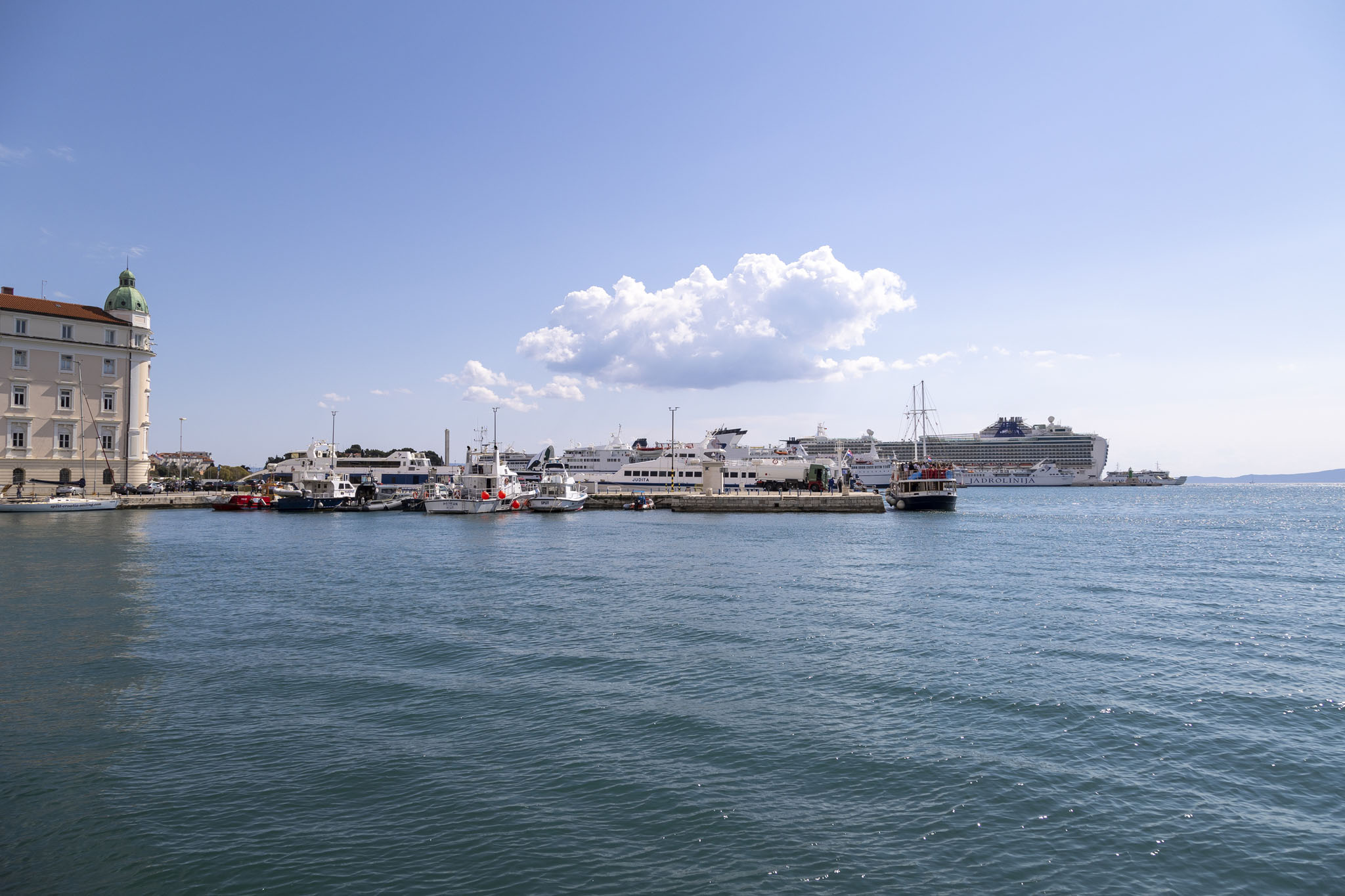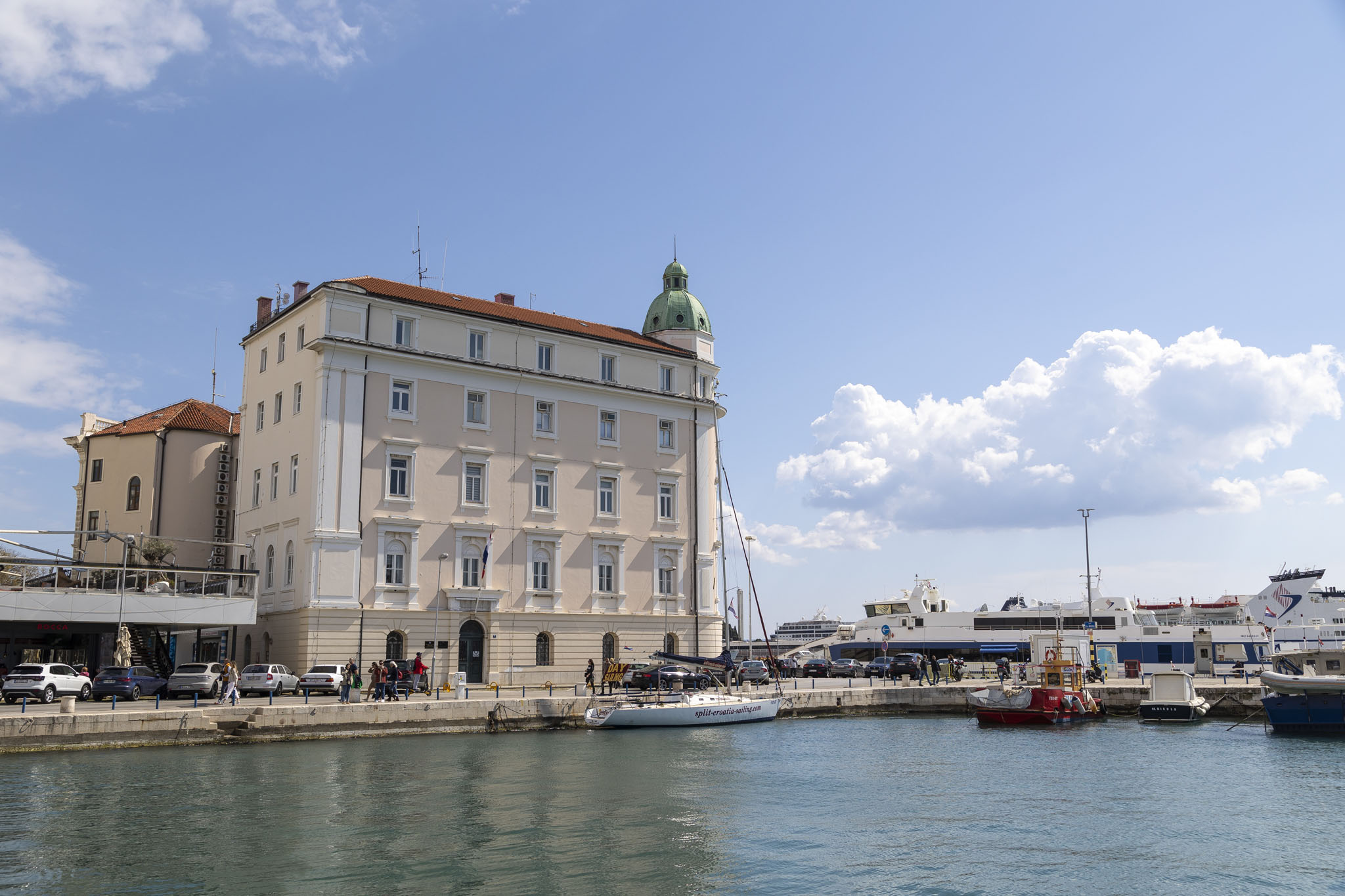The final part of our excursion while docked at Split in Croatia actually brought us back to the city for a short walking tour to view some of the highlights. Our bus arrived at the southeastern corner of the old part of Split and the direction to the ship was pointed out for those who now wanted to wander off on their own, but we decided we’d stick with the tour group as this was our first time in the country.
The place that everyone visits when they’re in Split is Diocletian’s Palace, and you will too if you come here. You just won’t be able to help yourself.
The palace is more accurately a miniature garrison town in its own right, originally having been built at the end of the third century CE as a home for the retiring emperor Diocletian with room for soldiers and family, all within a square structure modelled on Roman forts. In the centre of each long wall there was a gate, each with its own name, and the one on the southern side through which our guide led us was called the Bronze Gate. This would originally have been on the water’s edge aligned with the walls of the first picture in this post so you can see how much waterfront land has been reclaimed over the centuries, and it would originally have been the way by which Diocletian would have entered the complex by boat. Or swimming. Maybe he liked a nice swim.
Passing through the Bronze Gate took us into the cellars, the original purpose of which in addition to obviously housing wine and food, was to raise the level of Diocletian’s private apartments above with their south-facing views of the Adriatic. In the medieval period these cellars were occupied by refugees seeking protection within the city’s walls.
Once you enter the main court of Diocletian’s Palace – you’ll know you’re there from the crowds if nothing else – you’ll be greeted by the bell tower of the Cathedral of Saint Domnius behind the impressive peristyle (the tall porch of columns around the courtyard) and a granite sphinx.
Part of the cathedral was formerly the mausoleum of Diocletian while the bell tower was an addition in around 1100 CE, originally sporting Romanesque designs fitting in with the surroundings but losing many of them in renovation work undertaken early in the twentieth century. The result is still not displeasing to the eye, though.
The sphinx is the last remaining intact of what might have originally been twelve of the sculptures brought to the palace as guardians of his body after death by Diocletian. Believed to be from around the reign of Thutmose III who ruled as pharaoh in Egypt in the mid-1400s BCE, the sphinx is unusual in having human arms rather than lion paws.
We’d entered Diocletian’s Palace from the south gate so it made sense to exit through the north gate and that’s what we did after winding our way through some narrow alleys out of the main court. This brought us to the Golden Gate, although the gate names and their association with metals dates from centuries later than the period in which Diocletian would have lived in this part of Split. The area just within the city walls from this gate would have been a guard passageway.
Just outside the city walls we could see two impressive, towering sights. It’s hard not to have your eyes drawn immediately to the classic square tower form with pyramidal top of the bell tower and the Chapel of the Holy Arnir, unless there’s a huge sculpture to Gregory of Nin dominating the view instead, and that was the case here.
The bell tower was only finished in the early eighteenth century, an addition to what had been an eleventh century monastery on this site. In the late nineteenth century the bell tower was gutted by fire and the monastery was demolished several decades later leaving just the tower behind.
Gregory of Nin was not, as his name might imply, a musician who worked with Trent Reznor. It’s simply a location name, silly. He was a bishop responsible for conducting masses in Croatian rather than Latin in order to make them more accessible to the local populace and he often had differences of opinions with his superiors in the church. The sculpture was erected in 1929, originally located in the peristyle of the palace, then moved when the Italians occupied Split in World War II, and moved once more to its current location in 1954.
As is often the case with many metal statues around the world, rubbing one part of it is said to bring luck. Nobody knows why this started or what sort of luck can possibly be brought by touching metal that’s also just been touched by countless nose-wipers and recent toilet-users who’ve not washed their hands – unless it’s the luck of seeing if you can avoid catching something that upsets your digestive tract – but if you want to chance your arm and/or you’ve got a foot fetish then Gregory of Nin is waiting for you in Split.
Our walking tour of Split finished with a wander to a couple of squares and we started with the People’s Square (not its official name, but the one by which it’s known).
This part of Split was the first to be occupied by people once they started to move outside the protection of the city walls of Diocletian’s Palace. It was a bright, open space surrounded by buildings in a variety of styles and for varying purposes. The most notable feature about this spot was that it connected to the palace by the western gate; this was the Iron Gate, a narrow entrance with a church tower in the Romanesque style erected above and to one side of it, and with an unusual and attractive Renaissance era clock face featuring 24 hour markings.
A little to the south of People’s Square was another with the local name of Fruit Square thanks to its history of serving as a marketplace; the official name, though, is Radić Brothers Square. This irregularly-shaped square was quieter than the one we’d come from, largely shaded thanks to the remains of a fifteenth century Venetian castle, and, for me, a little more pleasant for both those reasons and the Baroque touches on the architectural styles of the buildings that lined its edges. A statue of the national poet of Croatia, Marko Marulic, rounded off this charming spot in Split just nicely.
We could have followed our guide back to the bus to be dropped off closer to the cruise ship at this point but, despite the heat of the day and us not being keen on a lot of heat in the day, it was just too gorgeous to do anything other than slowly walk back instead as we had time enough to do so. We headed out to the promenade to soak in some of the sights along Split’s gorgeous waterfront area and Marjan Hill in the distance forming a backdrop to the impressively large Church and Convent of St Francis before hugging the coast in the opposite direction and towards the port.
On this day where Azura docked at Split, Croatia we only spent a short period of time in the city itself so that we could see what was also nearby in Trogir in order to make the most of our time here and get a feel for the place. This was our first experience of Croatia and we loved it, even if there was more than a passing familiarity with much of the architecture and history thanks to visiting not-too-distant Montenegro a few years earlier. We’d absolutely love to return to Split at some point, and perhaps sooner rather than later, as it felt there was plenty more to appeal to our loves of history and architecture.
In the next post in this Azura cruise travelogue series we’ll complete our first day in Croatia with some time aboard the ship ahead of the sail away from Split.
